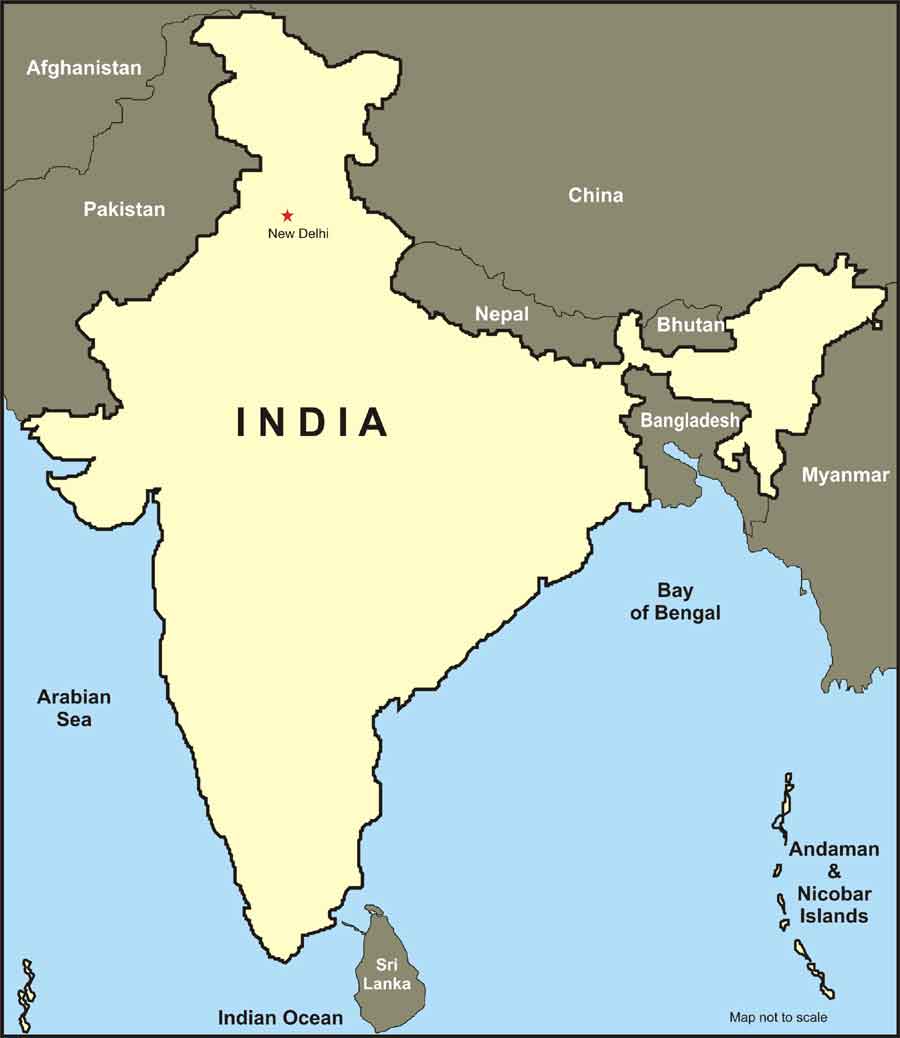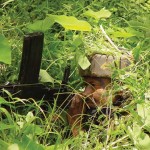With a landmass of sub-continental proportions, India occupies a predominant strategic position in Southern Asia and dominates the northern Indian Ocean with a coastline that is 7,683 km long, and an Exclusive Economic Zone (EEZ) that is over two million square km in size. India’s land borders exceed 15,000 km which it shares with seven countries including a small segment with Afghanistan (106 km) in northern Jammu and Kashmir (J&K). Lt Gen Vijay Oberoi (Retd) has given the following breakdown of the length of India’s land borders with its neighbours:1
- Bangladesh — 4,339 km (4,351 km as per MoD2).
- Bhutan — 605 km (700 km as per MoD).
- China — 3,439 km (4,056 km as per MoD).
- Myanmar — 1,425 km (1,643 km as per MoD).
- Nepal — 1,690 km (1,751 km as per MoD).
- Pakistan — 3,325 km (3,244 km as per MoD).
(In addition, India has a land border with Afghanistan as well. However, at present the area bordering Afghanistan falls in the Northern Areas of Pakistan Occupied Kashmir).
…the challenge of coping with long-standing territorial and boundary disputes with China and Pakistan, combined with porous borders along some of the most difficult terrain in the world, has made extremely effective and efficient border management mandatory.
Due to the proclivity of India’s neighbours to exploit India’s nation building difficulties, the country’s internal security challenges are inextricably linked with border management. Also, the challenge of coping with long-standing territorial and boundary disputes with China and Pakistan, combined with porous borders along some of the most difficult terrain in the world, has made extremely effective and efficient border management mandatory. However, in practice this has seldom been the case due to the lack of understanding of such military issues among the decision-making elite and inadequate interest in national security, particularly during the early years after independence. Despite several border wars and conflicts, India’s borders continue to be manned by a large number of military, para-military and police forces, each of which has its own ethos, and each of which reports to a different central ministry at New Delhi, with almost no real co-ordination in managing the borders.
External threats to India’s security are not the only border management issue to be dealt with at present by the national security apparatus. India’s rate of growth has far outpaced that of most of its neighbours which has generated peculiar problems like mass migrations into India. Other threats and challenges have also emerged. Dr G P Bhatnagar, former Inspector General, Border Security Force (BSF) has written that the border security scenario is marked by:3
- Increased cross-border terrorism.
- Infiltration and ex-filtration of armed militants.
- Emergence of non-state actors.
- Nexus between narcotics and arms smugglers.
- Illegal migrations.
- Left-wing extremism.
- Separatist movements aided and abetted by external powers.
- Establishment of madrasas, which could result in security hazards.
Smugglers, drug-traffickers and fund-amentalist terrorists are often in league with local criminals, lower rung political leaders and police functionaries. Such a situation exacerbates the challenges of border management, making it more complex for the border guarding agencies. It is axiomatic that poor border management inevitably leads to a volatile internal security situation in the border states of the country.
On the Tibetan side, the entire LAC is managed by Border Guards divisions of the Chinese People’s Liberation Army (PLA) under a single PLA commander of the Tibet Autonomous Region.
The employment of multiple forces results in problems of command and control as well as the lack of accountability for encroachments, poor intelligence and inept handling of local sensitivities.
Manning the Line of Actual Control with China
The Line of Actual Control (LAC) with China offers an illustrative example of the lack of co-ordination in border management. The western sector of the LAC in Ladakh and Himachal Pradesh and the central sector along the Uttrakhand border are manned by some Vikas battalions of the Special Frontier Force that reports to the Cabinet Secretariat and the Indo-Tibetan Border Police that is a Ministry of Home Affairs police force, respectively. Infantry battalions of the Indian Army man the Sikkim border and units of the Assam Rifles (AR) man the Arunachal Pradesh, Nagaland, Manipur and Mizoram borders. The AR is a para-military force under the Ministry of Home Affairs that is officered mostly by regular army officers. Its battalions have been placed under ‘operational control’ of local army formation commanders. Though the responsibility is that of the army, the AR battalions given to the army for border manning operations are not directly under its command. This arrangement is not conducive to fostering a professional relationship between the commanders and their subordinates.
Operationally, the Northern and Western Commands are responsible for military operations along the LAC in portions of the Western Sector. The Middle Sector on the Uttrakahnd border is under the operational jurisdiction of the Central Command, while the Eastern Sector along the Sikkim and Arunachal Pradesh borders comes under the operational control of Eastern Command.4 On the other hand, on the Tibetan side, the entire LAC is managed by Border Guards divisions of the Chinese People’s Liberation Army (PLA) under a single PLA commander of the Tibet Autonomous Region.
The Border Peace and Tranquility Agreement signed with the Chinese in 1993, and the agreement on Confidence Building Measures in the Military Field signed in 1996, were expected to reduce the operational commitments of the army from having to permanently man the difficult LAC with China. However, contrary to the usual assertion of the Ministry of External Affairs, it has not been possible to withdraw a single soldier from the border with China so far. In fact, despite the 1996 agreement on Military CBMs, several incidents of Chinese intrusions at Asaphi La and elsewhere in Arunachal Pradesh have been reported in the press and have been discussed in the Parliament. While no violent incident has taken place in the recent past, there have been occasions when Indian and Chinese patrols have met face-to-face in areas like the two “fish-tail” shaped protrusions in the north-east corner of Arunachal Pradesh.5 The patrol commanders on both the sides generally limit their inter-action to telling each other that the other side’s patrol is deep inside their territory and that such a violation should not be repeated. However, such meetings have an element of tension built into them and despite the best of training the possibility of an armed clash can never be ruled out.
There is an inherent contradiction in sending soldiers to patrol what they are told and believe are Indian areas and then tell them that they must not under any circumstances fire on “intruding” Chinese soldiers.
In the western sector in Ladakh, the lie of the LAC is even more ambiguous because of several “claim lines” and due to the paucity of easily recognisable terrain features on the Aksai Chin plateau. This makes it difficult to accurately co-relate ground and map, except in the area of the Karakoram Pass, which lies on the high Karakoram Range. Both the sides habitually send patrols up to the point at which, in their perception, the LAC runs. These patrols leave “tell-tale” signs behind in the form of burjis (piles of stones), biscuit and cigarette packets and other similar markers in a sort of primitive ritual to lay stake to territory and assert their claim. Again, while no clashes have actually occurred, Indian patrols have occasionally sighted Chinese patrols observing them from a discreet distance and “shadowing” them when they move parallel to the LAC.
These issues are debated during the meetings of the China Study Group that is jointly chaired by the Vice Chief of Army Staff (VCOAS) and the Foreign Secretary. While the MEA invariably advises caution, it is extremely difficult for commanders of troops to advocate a soft line to their subordinates. There is an inherent contradiction in sending soldiers to patrol what they are told and believe are Indian areas and then tell them that they must not under any circumstances fire on “intruding” Chinese soldiers. This is the reason why it is operationally critical to demarcate the LAC on the map and the ground after joint physical surveys. Once that is done, tall pylons or pillars that can survive the ravages of weather, can be put up about one to two kilometres apart without prejudice to the position of either side on their respective claim lines. Also, the inadequacy of recognisable terrain features can be overcome by exploiting GPS technology to accurately navigate up to the agreed and well-defined LAC on the ground and avoid transgressing it even unintentionally.
In this light, the Chinese intransigence in exchanging maps showing the alignment of the LAC in the western and eastern sectors, while talking of lofty guiding principles and parameters and a “framework” to resolve the territorial and boundary dispute is neither understandable nor condonable. It can only be classified as another attempt to put off a solution to the dispute “for future generations to resolve”, as Deng Xiao Ping had famously told Rajiv Gandhi in 1988. In other words, the dispute is to be resolved at a time when it is convenient to the Chinese and when they are in a much stronger position in terms of comprehensive national strength so that they can dictate terms and get away with it. At present, it is the Taiwan issue that is at the forefront of Chinese strategic thinking and Chinese belligerence on re-unification is there for the entire world to see. After the reunification of Taiwan, China is bound to turn its gaze southwards towards India and will be able to dictate terms from a position of military strength.






This distinguished Fellow forgets or overlooks that unless international disputes are settled through negotiation or arbitration the tensions are bound to continue and mere border management will never do. Also one should also give some thought to the other side opinions and arguments and should not always take a self-righteous stand, especially in border disputes with neighbors – the writer also fails to mention that we India have border disputes with almost every neighbor and have not settled any till now unlike China or Pakistan. What is much needed is a friendly, peaceful negotiating and persuading/compromising attitude with a ‘give and take’ approach.
no mention of tje important of tibet geopoltics issue between indo china